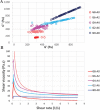3D-Printed Gelatin-Alginate Hydrogel Dressings for Burn Wound Healing: A Comprehensive Study
- PMID: 36404780
- PMCID: PMC9668585
- DOI: 10.18063/ijb.v8i4.618
3D-Printed Gelatin-Alginate Hydrogel Dressings for Burn Wound Healing: A Comprehensive Study
Abstract
Burn wound treatment is still a clinical challenge due to the severity of tissue damage and dehydration. Among various wound dressings, hydrogel materials have gained significant attention for burn wound treatment in clinical practice due to their soothing and moisturizing activity. In this study, 3D-printed dressings were fabricated using clinically relevant hydrogels for deep partial-thickness burn (PTB) wounds. Different ratios of gelatin and alginate mixture were 3D-printed and examined in terms of rheological behavior, shear thinning behavior, mechanical properties, degradation rate, and hydration activity to tune the hydrogel composition for best functionality. The cell-laden dressings were bioprinted to evaluate the effect of the gelatin: alginate ratio on the proliferation and growth of human dermal fibroblasts. The present findings confirm that the higher alginate content is associated with higher viscosity and Young's modulus, while higher gelatin content is associated with faster degradation and higher cell viability. Together, the 3D-printed dressing with 75% gelatin and 25% alginate showed the best tradeoff between mechanical properties, hydration activity, and in vitro biological response. Findings from in vivo test using the most effective dressing showed the positive effect of 3D-printed porous pattern on wound healing, including faster wound closure, regenerated hair follicles, and non-traumatic dressing removal compared to the non-printed hydrogel with the same composition and the standard of care. Results from this research showed that 3D-printed dressings with an adequate gelatin: alginate ratio enhanced wound healing activity for up to 7 days of moisture retention on deep PTB wounds.
Keywords: 3D printing; Advanced dressings; Alginate; Burn wound; Gelatin; Moist wound healing.
Copyright: © 2022 Fayyazbakhsh et al.
Conflict of interest statement
The authors declare that they have no competing interests.
Figures















References
-
- Kowal S, Kruger E, Bilir P, et al. Cost-effectiveness of the Use of Autologous Cell Harvesting Device Compared to Standard of Care for Treatment of Severe Burns in the United States. Adv Ther. 2019;36:1715–29. https://doi.org/10.1007/s12325-019-00961-2. - PMC - PubMed
-
- James SL, Lucchesi LR, Bisignano C, et al. Epidemiology of Injuries from Fire, Heat and Hot Substances:Global, Regional and National Morbidity and Mortality Estimates from the Global Burden of Disease 2017 Study. Inj Prev. 2020;26:i36–45. https://doi.org/10.1136/injuryprev-2019-043299. - PMC - PubMed
-
- Price K, Lee KC, Woolley KE, et al. Burn Injury Prevention in Low-and Middle-Income Countries:Scoping Systematic Review. Burns Trauma. 2021;9:tkab037. https://doi.org/10.1093/burnst/tkab037. - PMC - PubMed
-
- Zavlin D, Chegireddy V, Boukovalas S, et al. Multi-institutional Analysis of Independent Predictors for Burn Mortality in the United States. Burns Trauma. 2018;6:24. https://doi.org/10.1186/s41038-018-0127-y. - PMC - PubMed
-
- Yu TC, Zhang X, Smiell J, et al. Healthcare Resource Utilization, Treatment Patterns, and Cost of Care Among Patients with Thermal Burns and Inpatient Autografting in Two Large Privately Insured Populations in the United States. Burns. 2020;46:825–35. https://doi.org/10.1016/j.burns.2019.10.019. - PubMed
LinkOut - more resources
Full Text Sources
